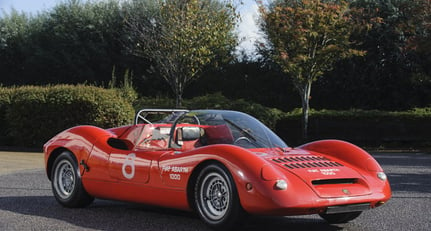1966 Abarth 1000
-
Year of manufacture1966
-
Chassis numberSE04/024
-
Lot number8
-
DriveLHD
-
ConditionUsed
-
Number of seats2
-
Location

-
Exterior colourOther
-
Drivetrain2wd
-
Fuel typePetrol
Description
From the Maranello Rosso Collection
1966 Fiat-Abarth 1000SP Tipo SE04 Racing Sports-Prototype
Registration no. Not registered in the UK
(previously registered in Italy: 461844 NA)
Chassis no. SE04/024
First registered in Naples on July 13, 1967, this delightfully presented and most attractive Abarth sports-prototype barchetta exemplifies the small-engined competition class that had such widespread support in Italian national competition for more than thirty years postwar. Used to the full in both circuit racing, and often tortuous mountain hill-climbs on public roads merely closed for a weekend's sport, this category of competition car had developed progressively from a widespread and deeply embedded tuning establishment making better use of mundane production Fiat economy saloon cars than the original manufacturer ever intended, or expected.
For the 1966 motor racing season Abarth of Turin produced its first multi-tubular chassised chassis and engine internally coded the 'SE04' model, designed by chief engineer Mario Colucci. Unlike his employer, Carlo Abarth himself, Mario Colucci believed that what had become the conventional mid-engined configuration with the power unit mounted behind the cockpit but ahead of the rear axle line was the way ahead. Abarth himself espoused the notion of an overhung rear engine, slung outboard of the rear axle a la Porsche practice, would promote better traction out of slow corners. Colucci argued that only exceptionally gifted drivers could make the most of such an outboard-engined configuration, and that since by definition the vast majority of Abarth's private owner/driver customers would not possess such exceptional talent the greater stability and predictability offered by the layout used so successfully by Cooper, Lotus, Ferrari, Lola, Ford Advanced Vehicles and almost every other mainstream pureblood racing car manufacturer was worth exploiting.
This philosophical division between Carlo Abarth and Mario Colucci is one of the most compelling, perplexing and yet charming aspects of the entire Abarth story. Colucci's neat little SE04 became a very successful model, its lightweight multi-tubular chassis frame proving rigid and practical and its all-independent coil-sprung suspension providing good and nimble handling. Notable design features included the nose-mounted oil cooler in its top-hatch mounting, while engine cooling was achieved by twin radiator cores in a hip mounting on each side just abaft the cockpit.
Power was provided by Abarth's familiar and very well-proven twin-overhead camshaft 4-cylinder power unit with three main bearings based upon the Fiat 600D cylinder block but with its capacity taken out to 982cc. With a compression ratio of 10.5:1 and breathing through two twin-choke Weber carburettors, this engine poffered some 105bhp at a lusty 8,000rpm. The large wrap-around windscreen conformed with contemporary FIA Group 6 sports-prototype regulations and the low-slung, elegant body paneling was in moulded glassfibre.
Around 105bhp in a sports-prototype weighing only some 480kg 1,058lbs gave a power-to-weight ratio of just on 10lbs per horsepower, and these sleekly-styled, well detailed and really very nicely built little sports-prototype cars were capable of some 220km/h 136mph dependent upon gearing.
The very talented English driver Jonathan Williams gave the new Abarth 1000SP its competition debut at the 14th Coppa della Collina event at Pistoia, but it was plagued by teething troubles and could place only fifth within the up-to-1,000cc prototipo class. However, on March 27,1966, a 1000SP driven by Giulio Tommasi won at the Roman Coppa Gallenga hill-climb to launch a successful season on the corsa in salita series, and Mauro Nesti won in a sister car at the legendary Parma-Poggio di Berceto 'climb. In circuit racing the cigar-chomping little Swiss star Herbie Muller won the 1000cc sports-prototype class of the important Nurburgring 500Kms in another 1000SP.
In 1967 when chassis '024' offered here emerged new from Abarth's Corso Marchione factory the model won at Lorentzweiler in Luxembourg, with emerging Dutch star Toine Hezemans at the wheel at Stallavena-Boscochiesanuova, Pietro Lado at Volterra, 'Matich' at Cividale-Castelmonte, and future Ferrari European Champion and team manager Peter Schetty on the Passo della Raticosa, another great classic Italian mountain-climb course. Tommasi won repeatedly in his 1000SP, as at Sorrento-Sant'Agata, Rieti, Monopoli, Popoli and on the Colle San Marco. Schetty won another classic at Trieste-Opicina, while Sergio Calascibetta earned Abarth their Fiat success bonus at Monte Pellegrino in Sicily and in the Coppa Nissena. Enrico Buzzetti won on the mighty Trento-Bondone 'climb and then significantly on the rugged and grueling Mugello public-road circuit in July. Rene Stierli won the class at the Swiss Ollon-Villars event in August, and so these pretty little cars with their raucous 8,000rpm exhaust note and nimble, well-balanced and stable handling characteristics really shone.
Into 1969 'Pal Joe'/Botalla won the 1-litre sports-prototype class in the World Championship-qualifying Monza 1,000Kms in their Abarth 1000SP, while Lado/Dona won in their's at the Imola 500kms in September. The 1969 Monza 1,000kms also saw the 1-litre class fall to an Abarth 1000SP, that time shared by 'White'/Umberto Grano.
The documentation file accompanying chassis '024' offered here includes its original Italian Carta di Circolazione registration booklet, dated June 9, 1967, and recording the car's original owner as Giuseppe Barrella of Naples, and its engine as a model 229A 4-cylinder of 982cc rated (modestly) as 70bhp at 6,400rpm. A Foglio Complementare document appended within the documentation file confirms the original price of '024' as having been Lire 4,120,000 and further confirms a change of ownership in January 1980 to Fabrizio Violati's SpA Bellancauto company in the Via della Conciliazione, Rome.
Thereafter '024' offered here was preserved as part of Fabrizio Violati's personal and fast-growing collection of fine Abarth cars, creating the basis of the Maranello Rosso Museum he subsequently developed in San Marino. The car remained within the Collection until earlier this year. Now as offered here the engine's cylinder bores have been inspected and as is to be expected after so long unused on static display are reported as being lightly glazed with evidence of surface rust, but the unit turns freely by hand. It also holds coolant with no leaks evident. Various water, oil and fuel hoses appear perished and would require replacing before use. Some brass contamination was found in the gearbox oil, the clutch is inoperable and as with all such long-term Museum cars a detailed mechanical inspection and careful preparation will be necessary before the car can be run.
It is, however, an outstandingly attractive example of a most interesting and now rare Abarth sports-prototype model that played a major role in the early careers of several leading European racing drivers. As a passport to entry in not only the world's leading Historic sports car events, but also (with its undeniable good looks) in Concours competition, this highly original and well-preserved little Italian beauty deserves the closest consideration.
Please note this vehicle is subject to the reduced import tax of 5% should it remain in the EU.


























